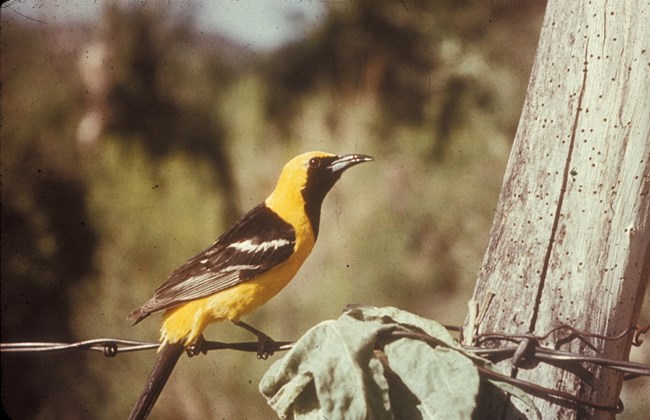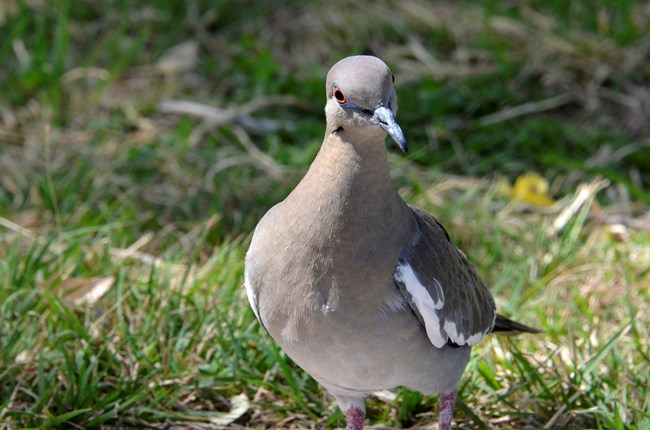Neotropical MigrantsJust as human "snowbirds" travel south to Arizona to escape harsh winters, many birds that breed in North America spend their winters in warmer, tropical climates. Birds that breed in Canada or the United States but winter in Mexico, Central America or South America are known as neotropical migratory birds. Of the more than 500 bird species found in Arizona, about half of those birds are neotropical migrants. These migrants include some of our most beloved such as hummingbirds, warblers, orioles and swallows. 
NPS photo Saguaro National Park and migratory birdsSoutheastern Arizona's isolated mountain ranges and river corridors are virtual desert oases, and thus are the preferred pathways for neotropical migrant traveling to or from their North American breeding grounds. For example, the lush vegetation along the San Pedro River provides food and cover for weary travelers, making it a super highway for neotropical migratory birds. At Saguaro National Park, the Rincon Mountains provide breeding grounds or stopover points for several species such as red-faced warblers, hooded orioles, painted redstarts, hepatic tanagers and zone-tailed hawks. The park also conserves a portion of another biome unique to the region: the saguaro cactus forest. Saguaros provide nest sites for cavity nesting birds like elf owls, purple martins and ash-throated flycatchers. Why are neotropical birds in trouble?Migratory birds face a long and difficult journey between their summer and winter homes. In addition to natural perils such as predation and extreme weather patterns, neotropical birds must also contend with human-caused threats. During their journey, migrants may encounter deadly herbicides, pesticides and industrial pollution. More importantly, an increasing number are losing their homes and migratory stopovers to ranching, farming, timber harvesting and urbanization. In places where development has broken breeding and wintering areas into small, isolated patches, predators can more easily find nests or roosting birds. Also, few people realize that house cats are the number one predator of birds in developed areas. 
NPS photo What does this mean for you?Neotropical migrants have great aesthetic, ecological and economic value. The arrival and departure of these migrants, like the white-winged dove in southeastern Arizona, marks the changing of the seasons. The beauty of these birds heightens the quality of our lives. They have integral roles in our environment as agents of insect control, flower pollination and seed dispersal. Their sensitivity to environmental degradation makes them valuable indicators of the quality of the environment we share. Southeastern Arizona's rich assortment of neotropical migrants attracts thousands of bird watchers every year. These birders bring in millions of dollars for the state's economy. What can you do to help?There are many things you can do to help conserve neotropical migrants while helping other wildlife in the process.
You can also help by supporting some of the groups that are working to conserve neotropical migrants Partners in Flight (PIF)PIF is a nonprofit international coalition of private individuals, government agencies and non-governmental organizations committed to conserving nongame land birds on a global scale. Arizona Partners in Flight (APIF) is an offshoot from this international program. APIF works to maintain healthy bird populations and thier habits in Arizona. APIF cooperates with neighboring states, including those in Mexico, to protect birds that know no borders. Access these programs at pwrc.nbs.gov/pif and nbs.nau.edu/FNF/PIF. The National Audobon SocietyThe National Audobon Society strives to conserve natural environments and wildlife with a focus on birds. The local chapter, Tucson Audobon, has a complete year-round program of birding events and projects open to members and other interested participants. Their office and store are located at 300 University Blvd. #120 Tucson, AZ 85705. The store features an amazing selection of reference books for birds of the world as well as bird materials, binoculars and gifts. To sample some of the organizations programs, go to audobon.org and tucsonaudobon.org. The Tucson office can be reached at (520) 629-0510 |
Last updated: January 13, 2024
